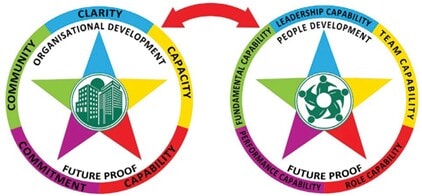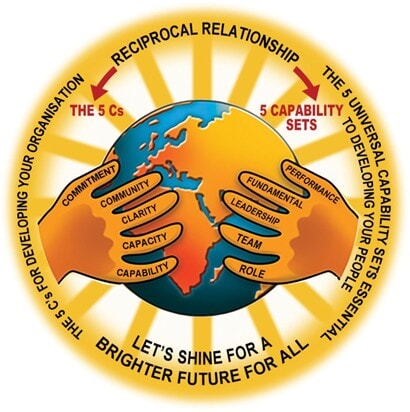
Future-Proof LMSs Will Not Run Out Of Runway
What Changes Must LMSs Undergo To Be Future-Proof?
There are three key imperatives to avoid the huge costs that have been invested in Learning Management Systems (LMSs) from becoming sunken ones, as LMSs run out of runway and face extinction. Importantly, whilst each imperative is key in its own right, there is a high level of mutual interdependence. The three imperatives to help future-proof LMSs are:
Imperative 1: LMSs Must Be Adapted To Become The Bank Vaults Of Institutional Capacity
In their book, The Big Con, Mariana Mazzucato and Rosie Collington point out that many organizations and institutions have lost ownership of their organizational capacity. In the context of this article, I support their argument for investment in and for collective intelligence to be and remain within all organizations and institutions. However, this can only happen if organizations have the means and mindset to do so.
Leadership must require that their organizations have complete ownership of their institutional capacity. That is, of the performance systems that enable the delivery of their strategy through their operational plan to fulfil their organization/institution’s purpose or mission. These performance systems need to be carefully and clearly documented and securely stored in a way in which they can be easily accessed for quick and easy reference. Importantly, there need to be sound disciplines and processes in place to continually improve, iterate, and innovate performance systems so that the organization can remain relevant in a fast-changing, global operating environment.
To future-proof LMSs, they must then be repositioned and adapted to play a vital role as the bank vault for institutional capacity. That is, to become the store for the sum of the unique systems, processes, methods, and ways of working that enable the organization to effectively deliver its purpose or mission. To be effective, an LMS “bank vault” must be easy to deposit into and easy to access. And there must be a disciplined, systematic, and systemized approach to ensuring that the contents of this bank vault are kept relevant.
Any team member, anywhere in an organization, must be able to access exactly the help they need, at the time they need it, without leaving the flow of work, through any smart device. For example, this could be as simple as having a QR code on a machine to be able to access basic fault-finding and remedy by way of a micro-support program (MSP). The MSP may be a simple video or a set of simple instructions to follow.
Clearly, there also needs to be a mindset and a discipline for everyone to be continually seeking better ways of doing things. People doing the work most often have the clearest insights into this and they must feel empowered and recognized for doing so. However, it is important that Subject Matter Experts (SMEs) are appointed to be the gate-keepers. All new ideas should be rigorously tested, and if they work, they must be seamlessly integrated as established new best practice.
This way, institutional capital resides with the organization rather than with the people who may come and go. It avoids needing to pay unreasonable incentives to keep people with specialized knowledge. In addition, this approach has the added value of people who move on having a vested interest in the success of their investment in the organization, secured in the LMS bank vault.
- Call to action
LMS providers make this happen or risk a diminishing “shelf-life”!
Imperative 2: LMS Developers Need To Find And Apply The Missing Link In The IQ-EQ-AQ Continuum
The potential of people to add value within organizations was, for a long time, measured in terms of intelligence quotient (IQ) or similar measures of cognitive ability. In the 1990’s, Daniel Goleman argued that it was not cognitive intelligence that guaranteed business success but emotional intelligence (EQ).
Most thought leaders on organizational effectiveness agree that cognitive ability and the ability to build relationships and to work collaboratively and inclusively with others are important. Now, it seems that the “new kid on the block” is Artificial Intelligence (AI), or more importantly our human ability to leverage it. But this cannot and will not happen adequately without context intelligence (CQ). CQ is the link that many will miss in the value chain.
The internet has democratized access to information. Most knowledge and information is now available to anyone who is online. But this is of limited value unless we can intelligently search, sift out, and then apply what is relevant to our needs. However, to do this effectively, we need a deep and holistic understanding of every aspect that must combine to work synergistically and holistically to achieve a sustainable, high performance organization. In short, we need a comprehensive framework to provide context for integrating, systemizing, storing, and continually evolving all best practices. In doing so, it is essential to understand the exact role and value-add of each, and how they fit and work together to develop and maintain highly effective organizations.
My research, over the last ten years, has led me to the conclusion that organization development and people development are flip sides of the same coin that organizations must mint to secure a future that shines and does not lose its luster. The “coin” diagram below represents a high-level summary that provides context for everything that must happen for organizations to be highly effective and stay that way. Importantly, this is supported by models and frameworks that provide deep understanding of the systems and symbiotic relationships that govern optimum effectiveness.

- Call to action
We cannot allow the “tail to wag the dog”. What do I mean by this? Simply put, the sum of AI cannot be allowed to trump the sum of our human IQ and EQ. CQ allows us to leverage the massive opportunity that AI offers to organizations. It allows us as intelligent beings to leverage the genius of the AI that we have created. Without it, it allows AI the potential to disempower us and our organizations, just as Mazzucato and Collington bear testimony to what the consulting industry did to businesses and governments.
Imperative 3: LMS Developers Must Give Leaders And Teams A Reason To See Future-Proof LMSs As A Strategic Tool That Adds Observable, Ongoing Value To Their Organizations
I have concluded that for organizations to be highly effective and remain that way, organizational development and people development initiatives must work together in synergy and simultaneously, with the value of the role of each initiative being clearly understood in the overall context of achieving and maintaining a highly effective organization.
The most efficient and effective approach to developing highly effective teams and cumulatively highly effective organizations is to create a cadence of simultaneous organization development and people development initiatives. To be effective, the approach must be holistic, that is, that the intention of each intervention must have clear context in terms of the benefit that the outcome will have for the team, and cumulatively the organization. In my interventions, this context and relevance is contextualized holistically in terms of the models and framework I have developed. Importantly, the benefit must be immediate and apparent to leadership so that there is motivation to sustain the cadence of continuous improvement. To achieve this, the interventions should be:
- Short (ideally of half hour duration or at least less than an hour)
- Regular (weekly or bimonthly)
- Having a specific outcome that makes the team stronger and/or healthier.
- Developing, refreshing, or extending an aspect of capability for each team member.
- Easy to facilitate for team leaders.
- Technologically savvy to optimize effectiveness.
- Specific, so that AI can be effectively used to quickly generate customized resources, such as videos and case studies to support facilitators.
- Leveraging social and vicarious learning opportunities.
The interventions may be synchronous (all teams working to a similar program, with a logical start and end point) or each team selecting interventions according to their priority needs as identified in an assessment as follows (an example of leveraging technology). For the sake of clarity, I demonstrate how I use LMS technology to do this in the link referenced in the “Additional Resources” section below the article.
Because the needs are contextualized and specific, AI can be used to quickly generate a suite of appropriate customized video and other support resources. And then, it is quick and easy to create a facilitator’s guide that enables team leaders to facilitate short powerful sessions with valuable OD and team skills outcomes, on a regular or as needs basis. For example, a team may be struggling with commitment and specifically with the key construct of accountability. An OD intervention to address this would be most effective if it engaged social and vicarious learning that facilitated accountability in the team as key to building their commitment, and at the same time refreshed, extended, or developed the relevant performance capabilities to ensure that the outcomes/improvements were sustainable.
- Call to action
A holistic understanding of context guides this simple, but not simplistic, approach. I urge Learning and Development professionals to try it, it works.
Conclusion: Future-Proof LMSs
Organization development and people development are flip sides of the same coin that organizations must mint for a future-proof currency (an organization that has and adds value, and remains relevant). LMS providers can ensure their position in the value-add chain by adapting their technology and approach to achieve all three imperatives listed above. In this way, they can support organizations to effectively deliver their worthy and worthwhile purpose and, ultimately, cumulatively create and maintain a better world for all.

Image Credits:
- The images within the body of the article were created/supplied by the author.
Additional Resources:
Source link



